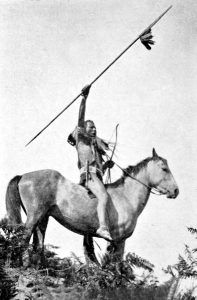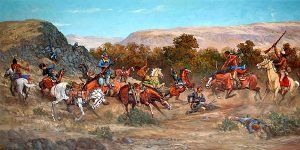Between the years of 1855 and 1858, the Yakama Indians (spelled Yakima at the time) were living along the Columbia and Yakima Rivers on the plateau in central Washington Territory. Residing in an area that was “in the way” of white settlers, most particularly miners looking for their fortunes, the first governor of the newly formed Washington Territory, Isaac Stevens, along with the Superintendent of Oregon Territory, Joel Palmer, sought to move the Yakama, as well as the Walla Walla, Umatilla, and Cayuse tribes on to reservations in 1855. Ceding over six million acres to the U.S. government in exchange for $200,000, the Indians were promised that white miners and settlers would not be allowed to trespass upon their lands.
However, when gold was discovered in the Colville area and in the Fraser River area of British Columbia, the miners ignored the rules. They trespassed anyway, sometimes stealing the Indian’s horses and mistreating their people. When some of the Yakama warriors retaliated by killing miners in isolated incidents, Andrew J. Bolon, the Indian sub-agent at The Dalles, was sent in to investigate. When he, too, was killed, troops were sent into the Yakima Valley, starting the Yakima Indian War in October 1855.
As the troops flooded the region, the Yakama united with the Walla Walla and Cayuse tribes, and several raids and battles occurred. The last phase of the Yakima War, referred to as the Coeur d’Alene War or Palouse War, came in 1858 when a force under the command of Colonel George Wright was sent in to deal with the Indians. In September 1858, Wright’s troops defeated the Yakama and their allies in the Battle of Four Lakes near Spokane, Washington.
Though the main Indian leader, Yakama Chief Kamiakin, fled to Canada, 24 other chiefs were captured and then hanged or shot. The remainder of the tribes were then permanently placed on reservations.
©Kathy Alexander/Legends of America, updated February 2024.
Also See:
Frontier Skirmishes between the Pioneers & the Indians


